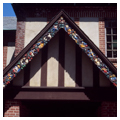You are here
Brookside School (The Meeting House)
Brookside School originated in The Meeting House. Located at the southern end of the since enlarged complex, the rustic Arts and Crafts pavilion was designed by Booth and asymmetrically conceived in powerful stone rubble. It has a steep roof, oriel casement windows, and an irregular roofline. Detroit artist Katherine McEwen decorated the interior of the auditorium, and the furnishings came from the workshops of the Society of Arts and Crafts. In 1929, George Booth's son Henry served as the architect for additions to the original building, as well as for the adjoining Headmaster's Residence (1929–1930). The younger Booth's additions enhanced the Arts and Crafts flavor of the original in their massing and lively combination of stucco walls, brick trim, and slate roofs.
Peter Rose's new wing responds to the small size and scale, the irregularity, and the childlike qualities of the historic Brookside buildings, as well as to the heavy traffic on Cranbrook Road and the drop-off, and the River Rouge floodplain that bisects the site. The wing comprises the Vlassic Early Childhood Center, and the science and music sections with lofty, yet cozy, classrooms and a music studio for ensembles. A window-lined walkway joins the sections. Specially manufactured mottled concrete blocks in pale tan to gray are masterfully laid in the walls. Slate, steel, lead-coated copper, wooden beams, trusses, and decking make up the other building materials. Planted with native species in a project coordinated by Ann North and dedicated in 2010, Brookside Children's Garden serves as a science lab, a quiet reading area, and an outdoor art and multimedia studio.
Writing Credits
If SAH Archipedia has been useful to you, please consider supporting it.
SAH Archipedia tells the story of the United States through its buildings, landscapes, and cities. This freely available resource empowers the public with authoritative knowledge that deepens their understanding and appreciation of the built environment. But the Society of Architectural Historians, which created SAH Archipedia with University of Virginia Press, needs your support to maintain the high-caliber research, writing, photography, cartography, editing, design, and programming that make SAH Archipedia a trusted online resource available to all who value the history of place, heritage tourism, and learning.










